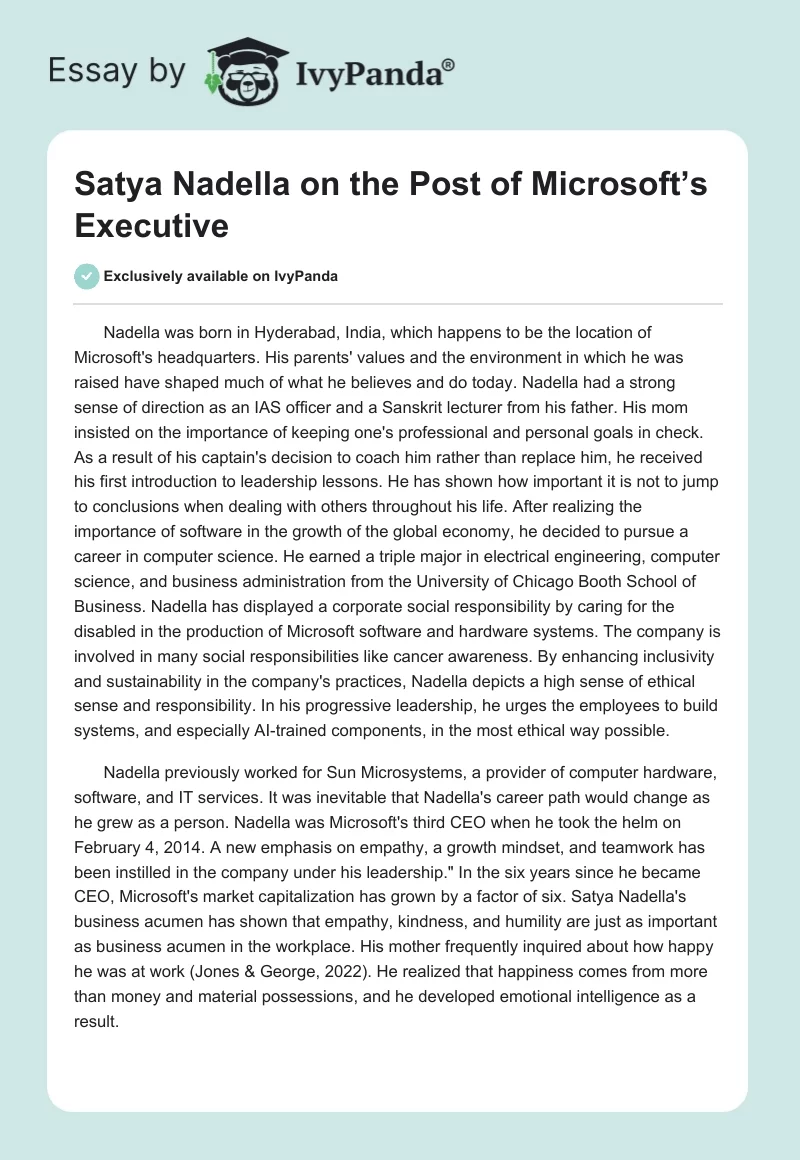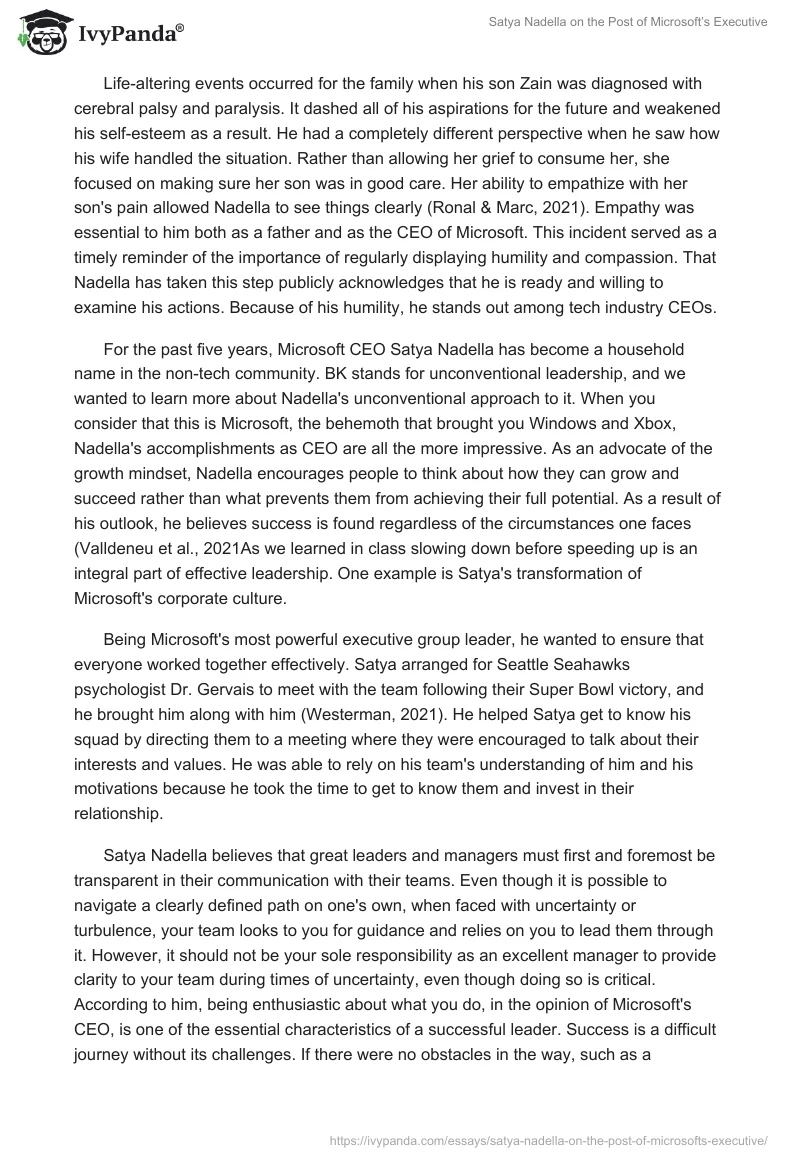Nadella was born in Hyderabad, India, which happens to be the location of Microsoft’s headquarters. His parents’ values and the environment he was raised in have shaped much of what he believes and does today. Nadella had a strong sense of direction from his father as an IAS officer and a Sanskrit lecturer. His mom insisted on keeping one’s professional and personal goals in check.
As a result of his captain’s decision to coach him rather than replace him, he received his first introduction to leadership lessons. He has shown how important it is not to jump to conclusions when dealing with others throughout his life. After realizing the importance of software in the growth of the global economy, he decided to pursue a career in computer science. He earned a triple major in electrical engineering, computer science, and business administration from the University of Chicago Booth School of Business. Nadella has displayed a corporate social responsibility by caring for the disabled in producing Microsoft software and hardware systems. The company is involved in many social responsibilities, such as cancer awareness. By enhancing inclusivity and sustainability in the company’s practices, Nadella depicts a high sense of ethical sense and responsibility. In his progressive leadership, he urges the employees to build systems, especially AI-trained components, in the most ethical way possible.
Nadella previously worked for Sun Microsystems, a computer hardware, software, and IT services provider. It was inevitable that Nadella’s career path would change as he grew. Nadella was Microsoft’s third CEO when he took the helm on February 4, 2014. A new emphasis on empathy, a growth mindset, and teamwork has been instilled in the company under his leadership.” In the six years since he became CEO, Microsoft’s market capitalization has grown by a factor of six. Satya Nadella’s business acumen has shown that empathy, kindness, and humility are just as important as business acumen in the workplace. His mother frequently inquired about how happy he was at work (Jones & George, 2022). He realized that happiness comes from more than money and material possessions, and he developed emotional intelligence.
Life-altering events occurred for the family when his son Zain was diagnosed with cerebral palsy and paralysis. It dashed all of his aspirations for the future and weakened his self-esteem as a result. He had a completely different perspective when he saw how his wife handled the situation. Rather than allowing her grief to consume her, she focused on making sure her son was in good care. Her ability to empathize with her son’s pain allowed Nadella to see things clearly (Ronal & Marc, 2021). Empathy was essential to him both as a father and as the CEO of Microsoft. This incident served as a timely reminder of the importance of regularly displaying humility and compassion. That Nadella has taken this step publicly acknowledges that he is ready and willing to examine his actions. Because of his humility, he stands out among tech industry CEOs.
For the past five years, Microsoft CEO Satya Nadella has become a household name in the non-tech community. BK stands for unconventional leadership, and we wanted to learn more about Nadella’s unconventional approach to it. When you consider that this is Microsoft, the behemoth that brought you Windows and Xbox, Nadella’s accomplishments as CEO are all the more impressive. As an advocate of the growth mindset, Nadella encourages people to think about how they can grow and succeed rather than what prevents them from achieving their full potential. As a result of his outlook, he believes success is found regardless of the circumstances one faces (Valldeneu et al., 2021As we learned in class slowing down before speeding up is an integral part of effective leadership. One example is Satya’s transformation of Microsoft’s corporate culture.
Being Microsoft’s most powerful executive group leader, he wanted to ensure that everyone worked together effectively. Satya arranged for Seattle Seahawks psychologist Dr. Gervais to meet with the team following their Super Bowl victory, and he brought him along with him (Westerman, 2021). He helped Satya get to know his squad by directing them to a meeting where they were encouraged to talk about their interests and values. He was able to rely on his team’s understanding of him and his motivations because he took the time to get to know them and invest in their relationship.
Satya Nadella believes that great leaders and managers must first and foremost be transparent in their communication with their teams. Even though it is possible to navigate a clearly defined path on one’s own, when faced with uncertainty or turbulence, your team looks to you for guidance and relies on you to lead them through it. However, it should not be your sole responsibility as an excellent manager to provide clarity to your team during times of uncertainty, even though doing so is critical. According to him, being enthusiastic about what you do, in the opinion of Microsoft’s CEO, is one of the essential characteristics of a successful leader. Success is a difficult journey without its challenges. Leadership would be a simple task if there were no obstacles in the way, such as a competitor’s product launch taking place a month early or a hurricane delaying the shipment of your goods. Many variables outside of your control exist in the real world, and you have little control over them. To be successful in your endeavors, you must steer the ship and get things done by overcoming obstacles and achieving success despite these obstacles.
References
Jones, G. and George, J., 2022. Contemporary management.
Ronald, B., & Marc, L. (2021). The leadership challenge in times of the COVTD 19 pandemic – An empirical investigation on the impact of transformational leadership on motivation and team performance. Advances in Management, 14(3), 1-21. Web.
Valldeneu, M., Tarrats, E., PhD., & Ferràs, Xavier, MBA, MBA, PhD. (2021). Leadership Styles and Organizational Outcomes: A Study Across International Hubs. Organization Development Journal, 39(1), 13-22. Web.
Westerman, G. (2021). Rethinking Assumptions About How Employees Work. MIT Sloan Management Review, 63(1), 1-5. Web.


